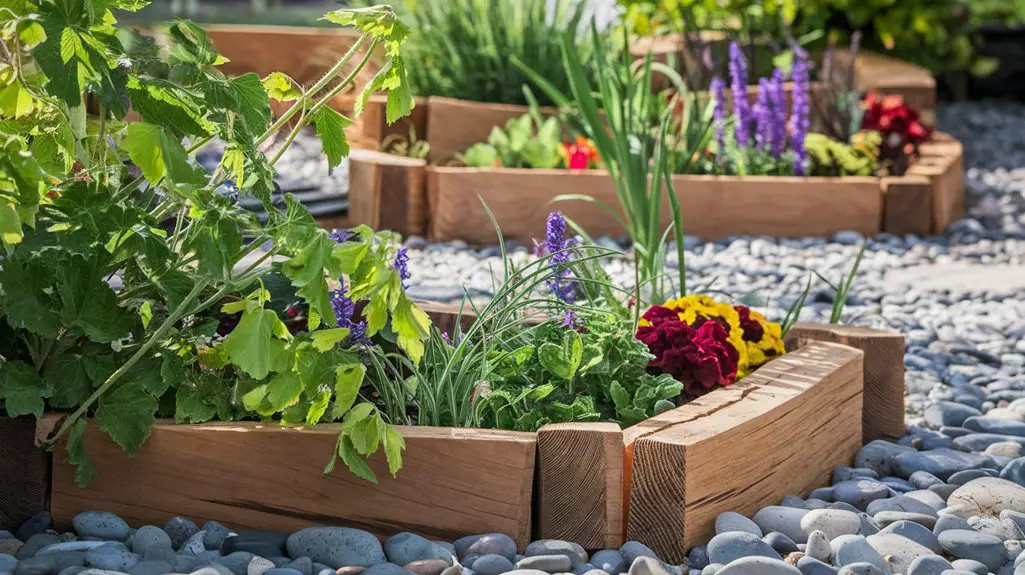Have you ever wondered how garden borders can transform your outdoor space? They do more than just define areas; they add style, structure, and even personality to your garden. From classic brick to vibrant recycled materials, each option offers unique benefits. Curious to discover which DIY ideas can elevate your garden's aesthetic while enhancing its functionality? Let's explore some creative ways to make your garden borders stand out.
Brick Edging
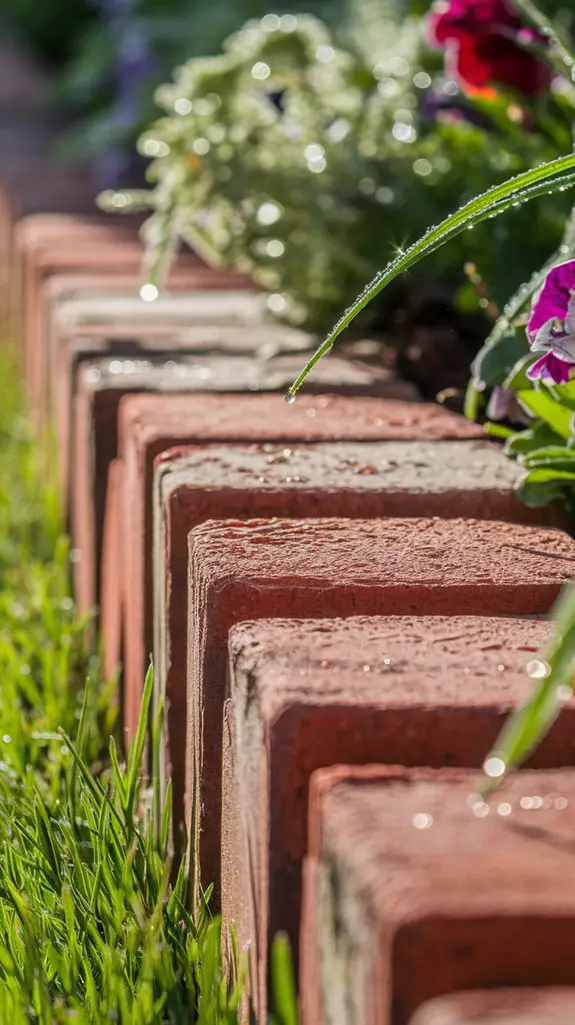
Creating a brick edging for your garden can transform its appearance in just a few hours. This neat arrangement outlines your garden bed, giving it a structured and polished look.
Start by selecting the right bricks—consider color and texture to complement your garden. Clear the area where you want your edging, making sure it's level.
Lay the bricks in a straight line or a gentle curve, depending on your preference. Use a rubber mallet to tap them into place, ensuring they're secure. Fill any gaps with soil or gravel to stabilize the bricks.
Once you're done, step back and admire your handiwork! A brick border not only enhances aesthetics but also helps keep soil and mulch contained, making maintenance easier.
Natural Stone Borders
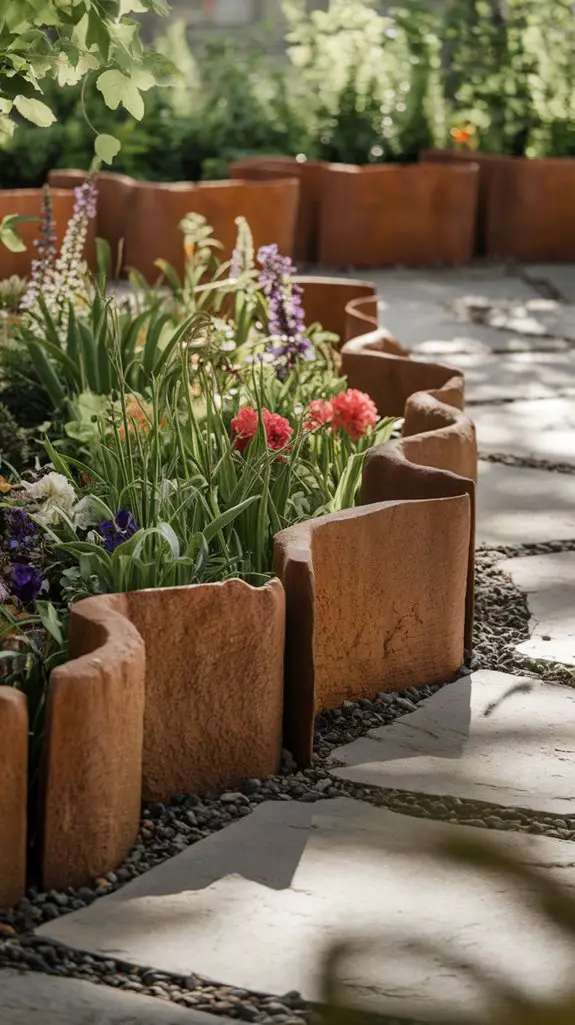
While brick edging offers a polished look, natural stone borders bring a rugged charm that can elevate your garden's aesthetic.
Imagine a stone-lined border crafted from a mix of large and small rocks, creating a rustic feel that invites nature right into your space. You can easily gather stones from your yard or nearby riverbeds, ensuring your garden reflects the local landscape.
To install, simply dig a shallow trench along your desired edge and place your stones, mixing sizes for visual interest. Fill gaps with soil or gravel to stabilize them.
This method not only looks stunning but also encourages biodiversity by providing habitats for beneficial insects. Embrace the beauty of natural stone, and watch your garden thrive in its earthy embrace!
Log Roll Edging
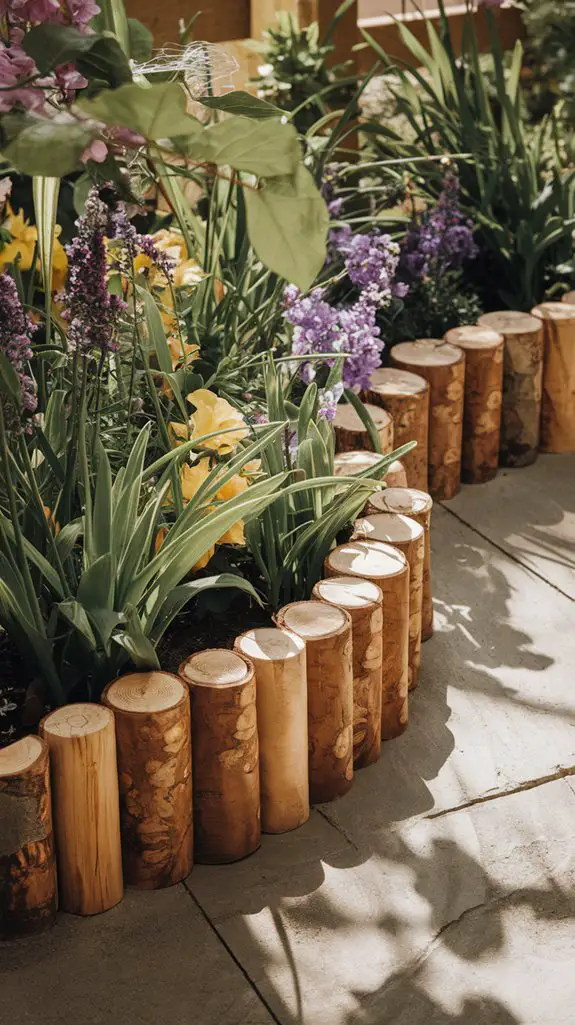
Natural stone borders add an organic touch to your garden, but if you're looking for a different kind of rustic charm, log roll edging might be just what you need.
This edging consists of a row of vertically placed logs, forming a natural-looking divider that beautifully complements any garden style.
Installing log roll edging is straightforward: dig a shallow trench, place the logs, and fill in soil around them for stability.
Not only does it define your space, but it also adds a whimsical, woodland feel. Plus, it's eco-friendly and can blend seamlessly with your landscape.
Just remember to choose untreated logs to avoid chemical leaching into your soil.
Embrace the charm and character that log roll edging brings to your garden!
Recycled Glass Bottle Borders
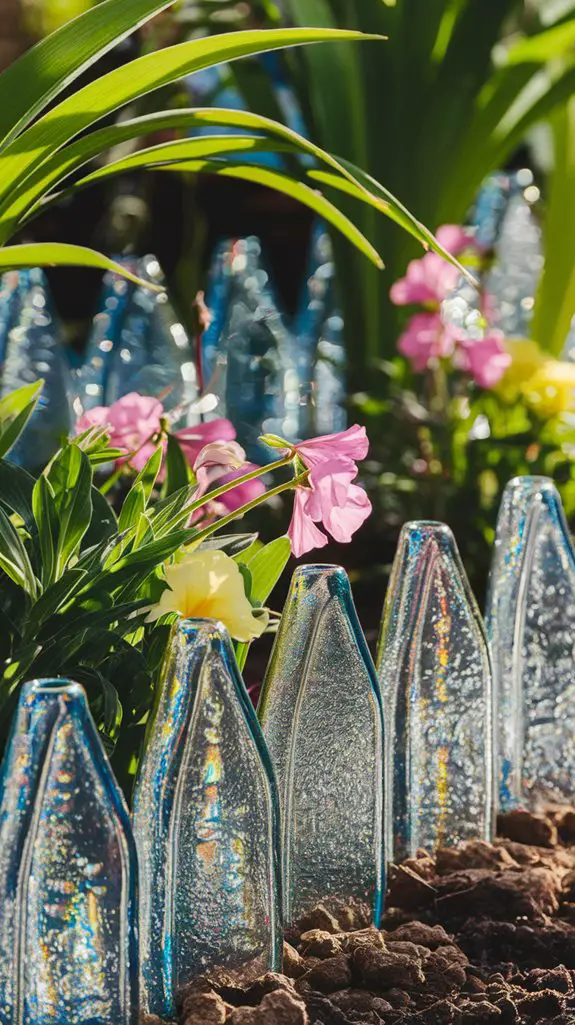
Transforming your garden with recycled glass bottle borders can add a splash of color and creativity. By using colorful glass bottles, you'll craft a unique edge that not only defines your garden but also showcases your personality.
Start by collecting bottles in various hues—think greens, blues, and ambers for a vibrant display.
Dig a shallow trench where you want the border, then place the bottles upside-down, half-buried in the soil. This technique creates a whimsical effect while keeping soil and mulch contained.
Plus, the light will catch the glass, adding sparkle throughout the day. It's an eco-friendly project that's both fun and functional, turning trash into a striking feature that will impress your guests and delight you every time you step outside.
Upcycled Wooden Pallet Edging
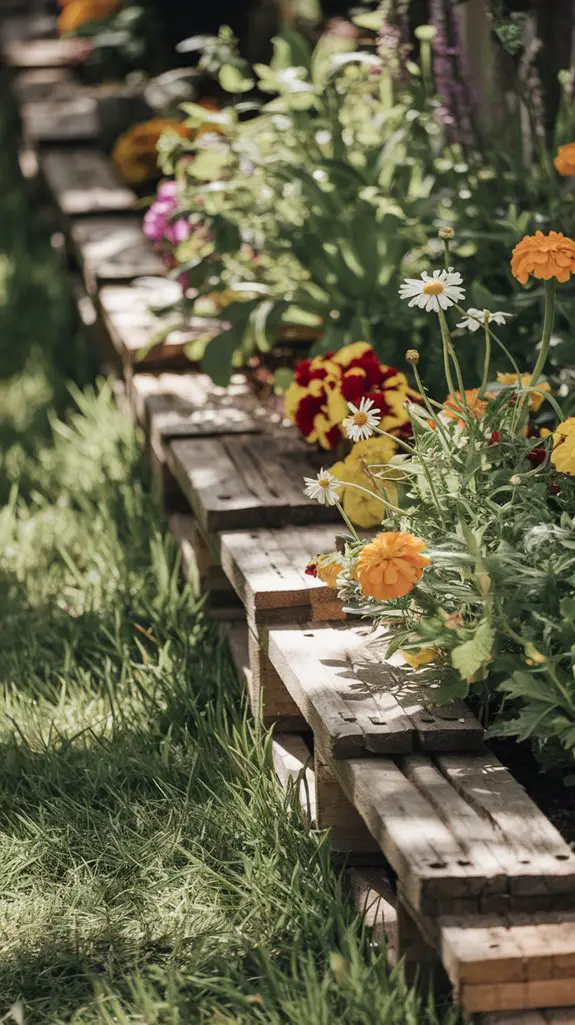
If you're looking to add a charming touch to your garden, upcycled wooden pallet edging might be just what you need. This eco-friendly option not only defines your space but also adds a rustic vibe.
Start by disassembling a wooden pallet—carefully remove the slats without damaging them. Cut the pieces to your desired lengths, creating a mix of heights for visual interest.
Next, arrange the slats in a line around your garden beds, securing them with stakes if needed. You can also leave some boards longer to create a unique layered effect.
Finally, give the wood a weatherproof finish or leave it natural for a more organic look. Your garden will shine with this creative, sustainable border!
Flower Border Frames
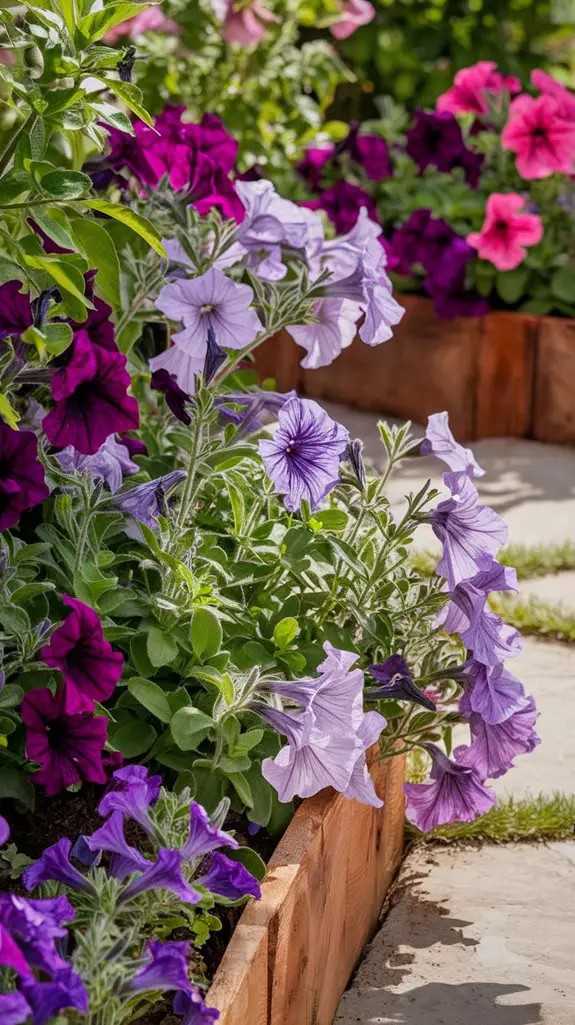
Flower border frames can elevate your garden's appeal with a touch of elegance and organization. By using low wooden frames, you create a natural barrier that not only defines your flower beds but also enhances their beauty.
These frames allow vibrant blooms to overflow, softening the edges of your garden and adding depth. To build one, simply cut wooden planks to your desired size, ensuring they're sturdy enough to hold soil and plants.
Arrange the frame in your chosen spot, fill it with rich soil, and plant your favorite flowers. As they grow, the blossoms will cascade over the edges, creating a stunning display.
Flower border frames are a practical way to keep your garden tidy while showcasing your floral creativity.
Gravel Strip Borders
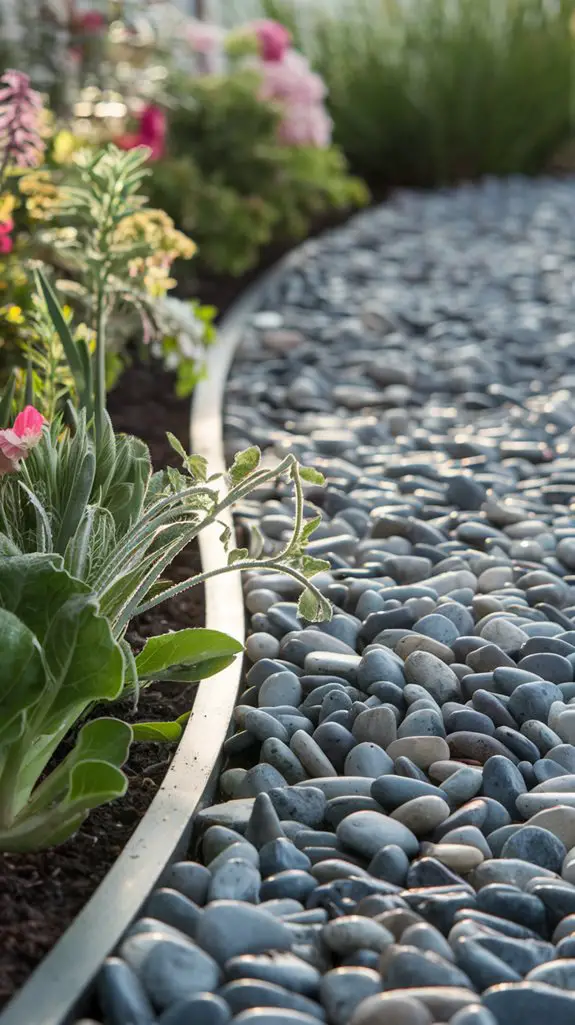
Creating a clean and contemporary look for your garden can be as simple as adding a gravel strip border. This minimalist approach effectively separates your lawn from flower beds, creating a defined space that enhances visual appeal.
To start, choose gravel that complements your garden's color palette—light stones can brighten darker areas, while darker gravel adds depth.
Once you've picked your gravel, dig a shallow trench along the desired border and fill it with your chosen stones. This not only marks the boundary but also helps prevent grass from encroaching into your flower bed.
Gravel borders are low-maintenance, allowing you to enjoy your garden without constant upkeep. It's an easy, stylish way to elevate your outdoor space!
Wrought Iron Garden Fencing
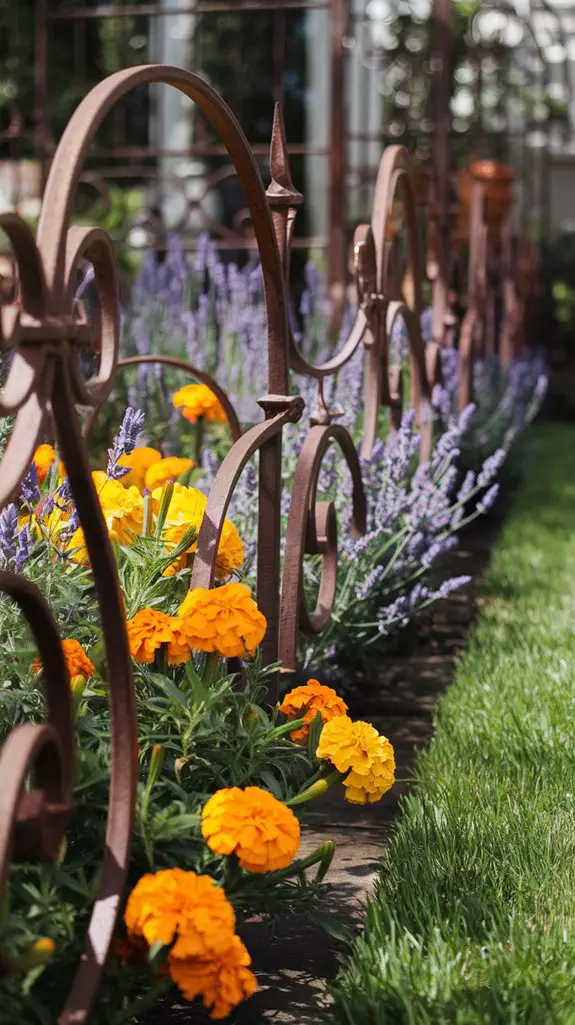
While you might think of fencing as purely functional, wrought iron garden fencing adds an elegant touch that elevates your outdoor space.
Its vintage charm pairs beautifully with various garden styles, whether you're cultivating a classic English garden or a modern landscape. The sleek black finish not only enhances visual appeal but also serves as a durable barrier to keep your plants safe from wandering pets or curious wildlife.
Installation is straightforward; simply secure the panels into the ground or along existing borders.
Plus, wrought iron is low-maintenance—just a quick wipe down now and then will keep it looking pristine.
Choosing wrought iron fencing not only defines your garden but also creates a stunning backdrop for your blooms, making your outdoor haven truly stand out.
Bamboo Border Edging
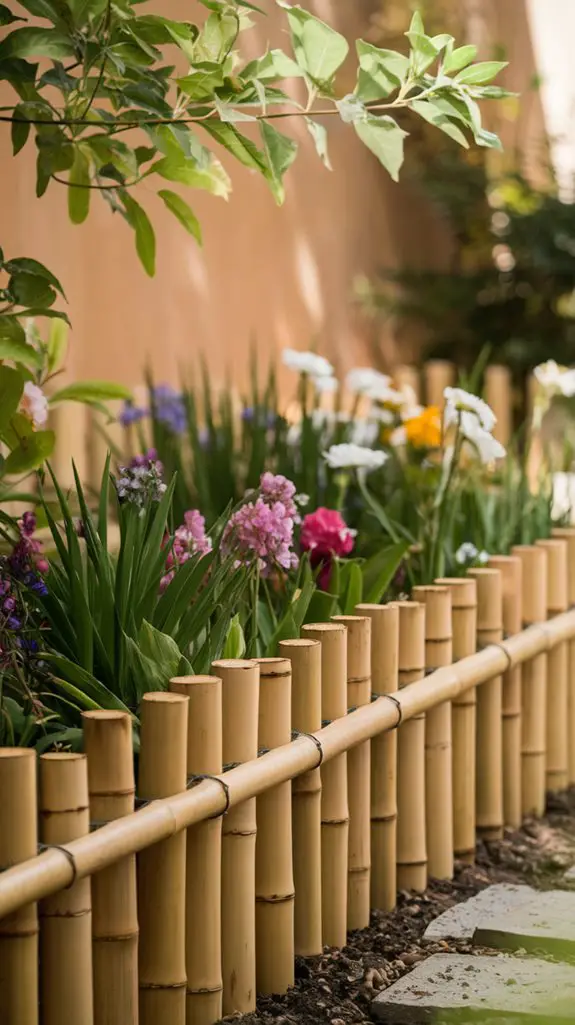
If you're looking for an affordable and eco-friendly way to define your garden space, bamboo border edging might just be the perfect solution.
With a row of thin bamboo poles, you can create an organic, tropical-style divider that enhances your garden's aesthetic. Bamboo isn't only sustainable but also durable, making it a great choice for outdoor use.
To set it up, simply drive the poles into the ground along your desired border. You can space them evenly for a neat look or cluster them for a more natural feel.
This versatile edging blends seamlessly with any landscape, offering a unique touch while keeping your garden areas distinct. Plus, it's easy to maintain, giving you more time to enjoy your garden!
Mosaic Tile Garden Border
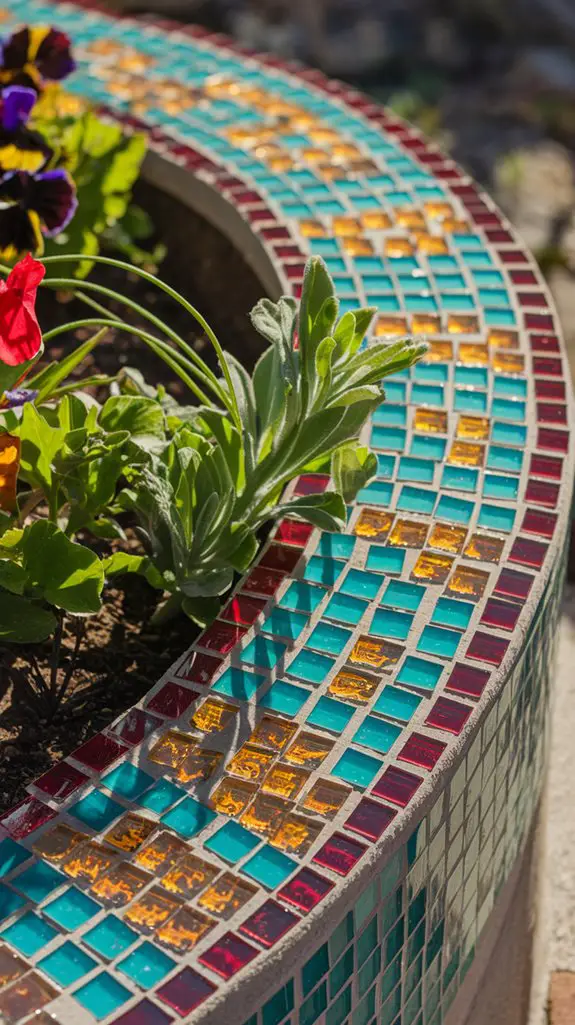
Transform your garden with a vibrant mosaic tile border that adds color and personality to any flower bed. Creating this eye-catching feature is simpler than you might think.
Start by selecting tiles in various shades and patterns that resonate with your garden's theme. Lay them out on a flat surface to design your unique pattern before installation.
Once you've decided on a layout, dig a shallow trench around your flower bed to set the tiles. Use mortar or adhesive to secure them in place, ensuring they're level.
Finally, fill in the gaps with grout and let it dry. This DIY project not only defines your space but also showcases your creativity, making your garden a true reflection of you.
Frequently Asked Questions
What Tools Do I Need for DIY Garden Borders?
You'll need a few essential tools for your project: a shovel, a level, a hammer, and some landscape fabric. Don't forget gloves for protection and a measuring tape to guarantee everything's perfectly aligned. Happy gardening!
How Do I Maintain My Garden Borders?
To maintain your garden borders, regularly trim overgrown plants, remove weeds, and refresh mulch. Water your borders during dry spells, and check for pests. Staying proactive keeps everything neat, healthy, and looking fabulous all season long!
Can I Mix Different Border Materials?
Mixing different border materials can create a unique look. You can combine stone, wood, and metal for texture and contrast. Just make certain they complement each other and fit your garden's overall aesthetic. Have fun experimenting!
How Deep Should I Install the Borders?
You should install your borders about 4 to 6 inches deep. This depth helps anchor them securely, preventing shifting and ensuring they withstand the elements while effectively defining your space. Proper installation makes all the difference!
What Plants Work Well Alongside My Borders?
When choosing plants alongside your borders, consider low-growing perennials like lavender or sedum. They'll create a beautiful contrast and add color while complementing the borders' structure, making your garden visually appealing and inviting.
Conclusion
By incorporating these DIY garden borders, you're not just defining your space; you're painting a vibrant picture of nature's artistry. Each border acts like a brushstroke, adding depth and character to your outdoor canvas. Whether you choose the elegance of brick or the whimsy of recycled glass, you'll cultivate a garden that reflects your personality. So grab your tools, release your creativity, and let your garden flourish with these unique edges that invite beauty and harmony into your yard!

